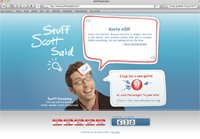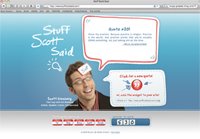 “Success is not the result of spontaneous combustion. You must set yourself on fire.”
“Success is not the result of spontaneous combustion. You must set yourself on fire.”
These famous words have been attributed to the likes of Alfred Hitchcock, Richard Pryor and Canadian Hockey legend Reggie Leach.
Sadly, we may never know who deserves the original credit.
IN REALITY: It doesn’t matter who said it.
All that matters is that YOU do it.
Now, I’ve done some preliminary research. And as far as I can tell, very few (if any) resources have been published on the topic of “How to Set Yourself on Fire.”
With the exception of Richard Pryor’s Wikipedia page, which reports that on June 9th, 1980, during the making of the film Bustin’ Loose, Pryor set himself on fire by freebasing cocaine and covering his body in 151-proof rum in a narcotic-induced psychosis, resulting in third degree burns of over half his body requiring a six-week recovery at the Grossman Burn Center at Sherman Oaks Hospital.
I assume you’re not going to go that route.
So, whether you’re rehearsing for a presentation, preparing for a sales call, gearing up for a pitch meeting – or just getting dressed for work – consider these nine ways to set yourself on fire without becoming a burn victim.
1. Saturate your consciousness with victory. During my daily appointment with myself, I ritually revisit the following reminders: (1) Action-based victories from the previous day’s accomplishments. This helps build momentum and self-confidence. (2) Personal victories in the form of affirmations of my highest talents and skills.
This is the oxygen – the fuel – that my fire requires to grow stronger. By doing this every morning for the past eight years, I’ve found my inner kindling to be perfectly prepared for ignition. I wonder what your consciousness is saturated with. How much time – each day – do you spend selling yourself to yourself?
2. Get in the zone – YOUR zone. Before every sales call, Dwight Schrute has a ritual: He sits in his vintage Trans Am the parking lot of the company he’s about to sell to, then blasts “Kickstart My Heart” by Motley Crue as loud as possible. So, is it any surprise he consistently wins Dunder Mifflin Salesperson of the Year?
Of course not. Because Dwight knows how to get in the zone. His zone. He knows how to set himself on fire. Personally, before every speech, I listen to the Rocky IV soundtrack in the bathroom stall while doing breathing exercises, creative visualization and positive affirmations. Works every time. Unless somebody walk in on me. Then it’s just plain awkward.
The point is, you can create whatever type of pre-game ritual you want. Anything that enables you to ride the wave. How do you get into the zone?
3. Dump the damp wood. Ever tried to make a campfire the morning after a thunderstorm? Good luck. Soggy wood never burns. (Looks like cold breakfast again!) In the same respect, you can’t set yourself on fire if the people in your life are dampening your flame.
That’s why you’ve GOT to make conscious choices about the individuals you allow to participate in your life. Learn to ask yourself questions like: Does this person add wood to my internal fire or sprinkle water on it? Is this person helping me become the best version of myself? Which people in my life don’t respect my time? Is this person a chronic abuser of my time and attention? Does this person enrich my life in any way?
Sure, it hurts to personally amputate people who don’t believe or support you. But living a non-flammable life hurts even more. Lesson learned: encircle yourself with kindlers. Life is too short to hang with people who don’t set you on fire. What damp wood do you need to throw back into the forest?
4. Sweep your fire radar. Have you ever gone through a “non-flammable” period in your life? Where you felt stuck, uninspired and stalemated? I know I have. And I remember when I sought counsel from my friend Dixie Dynamite. (With a name like that, I figured she could help.) Predictably, her response gave me chills: “Scott, if your soul was truly ignited, you would have noticed the flame.”
Damn it. Guess my fire is out, I thought. Fortunately, Dixie gave me the antidote. “If your flame is out, think back to the last time it burned brightly. What was happening? Who was around? How did you feel?” This exercise raises your awareness and makes you more available to future flames. Try it. How sharp is your fire awareness?
5. Surpass your personal threshold level. In Sam Parker’s book, 212° The Extra Degree, he explains, “At 211°, water is hot. At 212°, water boils. And with boiling water, comes steam. And steam can power a locomotive. The one extra degree makes the difference.”
Maybe that’s all you need. Maybe the bridge between flammable and incombustible is shorter than you think. Either way: The rest of the world is doing everything they can to prevent you from reaching that tipping point because they’re scared shitless that your success will eclipse their averageness.
I guess it depends how much you’re willing to give up to get what you want. What’s the one extra degree that will propel you beyond your threshold level?
6. Practice impossible patience. According to UL 94 Flammability Testing, one of the primary ignition characteristics is “long-term exposure to elevated temperature.” That’s interesting. Maybe the fuel for your the fire isn’t oxygen – it’s patience.
Of course, there’s only one problem with that: You won’t find patience anywhere on the periodic table of elements – only within. The hard part is having faith that the heat provided by your eventual flame will outweigh the wait it took to ignite it. Are you letting the internal movement of patience flavor your fire?
7. Firefighters are busy people. These guys work 24-hour shifts. Naturally, on their days off, the only thing they want to do is sleep. Which isn’t a bad thing if you’re an actual firefighter. However, if, as a leader, you spend most of your days putting out other people’s fires, you won’t have any energy left to start a one of your own.
Yikes. Maybe it’s time to start asking yourself: Who creates fires you waste time putting out? Think of it as a process of elimination. That way, setting yourself on fire becomes a mathematical certainty. You become gloriously unimpeded. That is, once all the crap has been laid aside. What’s preventing you from becoming the best, highest version of yourself?
8. You will need an ignition source. “A heat supply having sufficient energy to initiate combustion of a material.” That’s the official definition of ignition source, according to the National Fire Protection Association. Fortunately, the supply is endless. As long as your receptors are tuned into the frequency of inspiration, you’ll never be short of an ignition source.
The tricky part is figuring out how to fire inspiration into yourself. For example, during a 1998 interview between George Carlin and Jon Stewart, Carlin explained, “I don’t use drugs anymore, but I always have a joint nearby.” Now, I’m suggesting you partake in anything illegal. Rather, I challenge you think about the components of your ideal creative environment where ignition is pervasive. What’s your system for initiating creative combustion?
9. Balance energy expenditure with energy renewal. As I learned from The Power of Full Engagement, “The richest, happiest and most productive lives are characterized by the ability to fully engage in the challenge at hand, but also to disengage periodically and seek renewal.”
Lesson learned: The more time you spend “doing,” the more time you need to invest “being.” Suggestion: Create a ratio that fits your lifestyle – and stick to it. Be vigilant about protecting your non-negotiables. Personally, I’ve found great success with Mini Vacations.
Here’s how they work: Each day, spend anywhere from fifteen minutes to two hours. Then, go perpendicular to the task at hand. Engage different parts of your mind, body and spirit. Whether you meditate, go for a walk, watch an episode of Southpark or go play the ukulele – you will renew and expand your energy reserves, guaranteed. When was the last time you took a vacation?
REMEMBER: Spontaneous combustion isn’t enough.
Learn to set yourself on fire.
And soon, people will come back just to watch you burn.
LET ME ASK YA THIS…
How flammable are you?
LET ME SUGGEST THIS…
For the ebook called, “203 Things I’ve Learned about Writing, Marketing and Selling Books,” send an email to me, and you win the ebook for free!
* * * *
Scott Ginsberg
That Guy with the Nametag
Author, Speaker, Coach, Entrepreneur
[email protected]
 Who’s quoting YOU?
Who’s quoting YOU?
Check out Scott’s Online Quotation Database for a bite-sized education on branding success!

 PICTURE THIS: You just watched somebody give a speech.
PICTURE THIS: You just watched somebody give a speech.  Who’s quoting YOU?
Who’s quoting YOU?